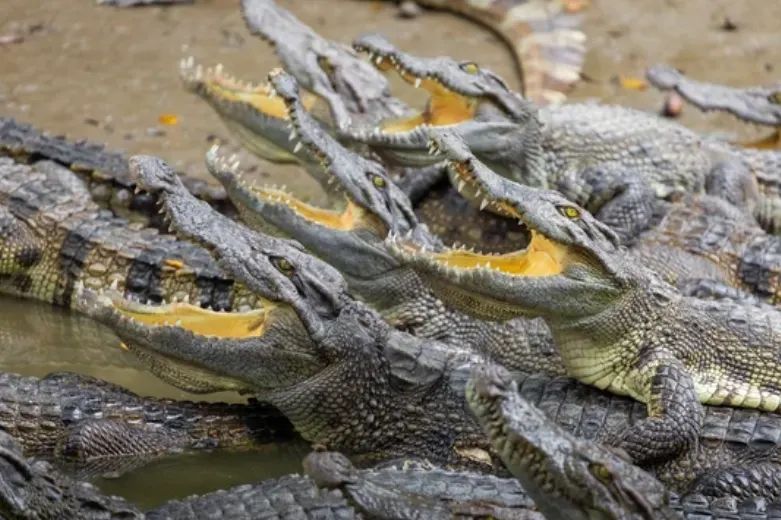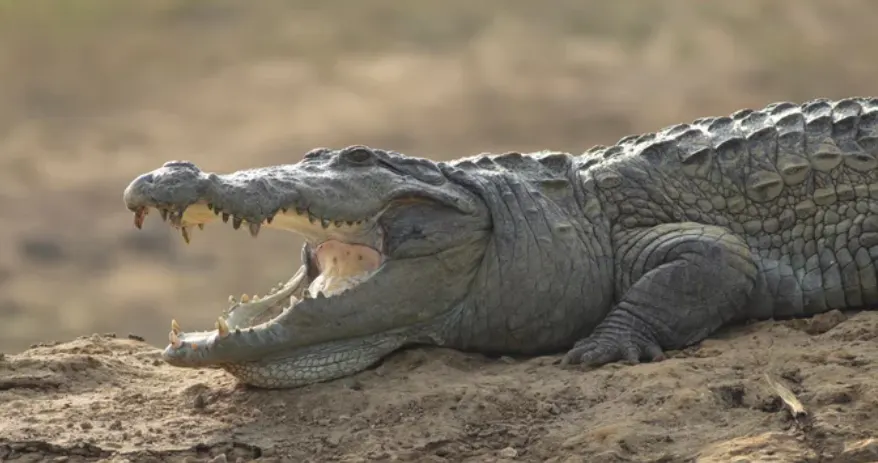Crocodiles, members of the Crocodylus genus, are among the most feared and revered reptiles in the world. Known for their powerful bodies, sharp teeth, and unparalleled stealth, these ancient creatures have remained relatively unchanged for over 200 million years. In this comprehensive guide, we delve into the world of crocodiles, exploring their characteristics, habitat, behavior, and their fascinating relationship with humans.

Table of Contents
Crocodile Overview
Scientific Classification
- Kingdom: Animalia
- Phylum: Chordata
- Class: Reptilia
- Order: Crocodylia
- Family: Crocodylidae
- Genus: Crocodylus
- Scientific Name: Crocodylus acutus
Quick Facts
- Conservation Status: Least Concern
- Locations: Africa, Asia, Central America, North America, Oceania, South America
- Diet: Carnivore
- Lifespan: 20 – 70 years
- Top Speed: 25 mph
- Number of Species: 13
- Fun Fact: Crocodiles are known to eat pebbles to aid in digestion and buoyancy.
Anatomy and Appearance
Crocodiles are large, semi-aquatic reptiles characterized by their thick, scaly skin made up of armored, waterproof plates. These scales, which can vary in color from dull olive and green to brown, gray, and black, serve as camouflage in their natural habitats. Crocodiles have broad heads with eyes and nostrils located on top, allowing them to remain mostly submerged while observing their surroundings.
One of the most remarkable features of crocodiles is their powerful jaws, capable of exerting immense pressure to capture and subdue prey. Their tails, which are vertically flattened, provide powerful propulsion in water, making them formidable hunters both in and out of the water.
Crocodiles also possess a transparent third eyelid that protects their eyes underwater while maintaining visibility. Their ears and nostrils can close off to prevent water entry, allowing them to stay submerged for extended periods. These adaptations make them highly efficient predators in their aquatic environments.
Distribution and Habitat
Crocodiles are found in a variety of wetland habitats across the warmer tropical waters of the southern Hemisphere. They inhabit rivers, lakes, marshes, lagoons, mangrove swamps, and estuaries, relying on these environments to regulate their body temperature and hunt for
Geographical Distribution
- Americas: The American crocodile (Crocodylus acutus) is the largest crocodilian species in North and South America, found in freshwater rivers and lakes, as well as brackish coastal waters near estuaries and lagoons.
- Africa: The Nile crocodile (Crocodylus niloticus) is found in freshwater marshes, rivers, lakes, and mangrove swamps across eastern and southern Africa.
- Asia and Australia: Estuarine crocodiles, the largest and most widely dispersed species, are found in river mouths and brackish swamps from the Bay of Bengal across Southeast Asia to Australia.
Behavior and Lifestyle
Crocodiles are cold-blooded reptiles, meaning they cannot internally regulate their body temperature. Instead, they rely on external sources of heat, such as basking in the sun during the day to warm up after spending time in the cooler waters. This behavior is essential for their survival, especially since they are nocturnal hunters.
Social Behavior
Crocodiles are surprisingly social animals, often forming large groups consisting of adults and juveniles. These groups have a clear hierarchy, with the largest male at the top. The dominant male enjoys the best basking spots and has priority during group feedings. This social structure is particularly evident in species like the Nile and Mugger crocodiles.
Communication
Crocodiles have a complex system of communication, using a variety of vocalizations to convey different messages:
- Chirping: Hatchlings make a squeaky noise just before they hatch, prompting the mother to move the eggs to the water.
- Distress Calls: Young crocodiles emit high-pitched sounds when threatened, alerting nearby adults.
- Hissing: Crocodiles use a hissing noise to warn potential threats or assert dominance.
- Bellowing: Males produce a deep bellowing sound during the mating season, which serves to attract females and deter rival males.
Cognitive Intelligence
Crocodiles are highly intelligent and have been observed studying the behavior of their prey before attacking. They have been known to use tools, such as placing sticks on their snouts to lure birds looking for nesting materials. Crocodiles also exhibit playful behavior, engaging in activities like wrestling and playing with objects, which is uncommon among reptiles.
Reproduction and Life Cycles
Crocodiles are known for their strong maternal instincts. After mating, the female lays between 17 and 100 eggs in a nest made of soil and vegetation. This nesting material helps regulate the temperature and humidity around the eggs, ensuring their development. In flood-prone areas, crocodiles build mound nests to keep the eggs safe from rising waters.
The incubation period lasts around three months, with hatchlings often emerging at the start of the rainy season. The mother fiercely guards the nest during this time, protecting the eggs from predators. Once the eggs hatch, the mother gently carries the young to the water in her mouth, where they will remain under her protection for up to two years.
Diet and Prey
Crocodiles are carnivorous predators with a diet that varies based on their size and habitat. Young crocodiles primarily feed on fish, crustaceans, and small mammals, while larger adults can take down much bigger prey, including deer, zebra, and water buffalo.
Crocodiles are ambush hunters, relying on their stealth and powerful jaws to capture prey. They often remain motionless in the water, waiting for the perfect moment to strike. Due to their slow metabolism, crocodiles can survive for long periods without
Predators and Threats
Adult crocodiles have few natural predators due to their size and strength. However, juveniles are more vulnerable and can fall prey to birds of prey, large mammals, and other reptiles. Human activities, such as habitat destruction and hunting, pose significant threats to crocodile populations worldwide.
Interesting Facts and Features
Crocodiles have evolved several fascinating adaptations that have contributed to their survival over millions of years:
- Salt Glands: Some species, like the American crocodile, have specialized glands that allow them to excrete excess salt from their bodies, enabling them to live in brackish and saltwater environments.
- Pebble Eating: Crocodiles are known to ingest pebbles, which help grind up
food in their stomachs and aid in buoyancy. - Dormancy: During periods of drought, crocodiles can enter a state of dormancy, burrowing into the mud and surviving without
food until water returns.
Crocodile vs. Alligator
While crocodiles and alligators are often confused, there are several key differences between the two:
- Snout Shape: Crocodiles have a pointed, V-shaped snout, while alligators have a broader, U-shaped snout.
- Size: Crocodiles, especially saltwater species, can grow much larger than alligators.
- Habitat: American alligators primarily inhabit freshwater environments, whereas crocodiles are more adaptable to saltwater habitats.

Relationship with Humans
Crocodiles have a complex relationship with humans. On one hand, they are feared as dangerous predators capable of attacking livestock and, in rare cases, people. On the other hand, crocodiles are revered in many cultures and play a crucial role in maintaining the balance of their ecosystems.
Efforts are being made to conserve crocodile populations, particularly those species that are endangered due to habitat loss and hunting. By understanding and respecting these ancient reptiles, we can ensure their survival for generations to come.
Crocodiles, with their formidable presence and ancient lineage, continue to captivate and intrigue us. As apex predators, they play a vital role in their ecosystems, and their survival is a testament to their remarkable adaptations and resilience in the face of environmental challenges.
- Enchi Ball Python: A Unique and Stunning Morph of Python regius - March 27, 2025
- Emerald Tree Monitor: The Enigmatic Green Guardian of the Rainforest - March 26, 2025
- The Egyptian Cobra (Naja haje): A Fascinating Serpent - March 25, 2025
